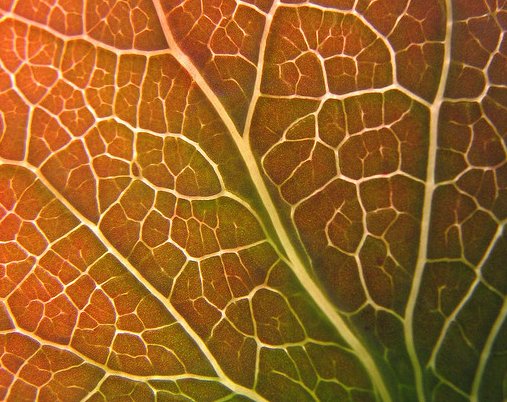Leaf Parts and Function
In a world surrounded by plants, no one would be surprised to find out that the leaves (leaf, singular) is one of the most important parts of a plant. A leaf is primarily an above the ground plant organ that is responsible for the process of photosynthesis. Leaves are normally thin and flat (laminar), which evolved as a means to maximize the overall surface area that is exposed directly to the sunlight.
The internal organization of the plant leaf has also evolved to maximize the exposure of the chloroplasts, which are the photosynthetic organelles, to light and for the increasing of the carbon dioxide absorption, in the process of photosynthesis.

Leaves come in many colours: photograph by Nekonomania.
Most plant leaves are composed of stomata, which is responsible in regulating water, oxygen and carbon dioxide exchange with the atmosphere. The structure and shape of a lant leaf differs considerably based on the climate or weather available in a certain location, basically due to the presence of light and the potential loss of water due to humidity and temperature.
Leaves are also the main site wherein guttation and transpiration in most plants take place. This plant part has the ability to store water and food, and is sometimes modified for specific purposes. The concentration of the process of photosynthesis in leaves makes them highly abundant with minerals, proteins and sugars. Due to their nutritional value, leaves serve as the prominent food for most animals. Even humans need to have a daily intake of different vegetables to get the right amount of nutrients needed by the body. Foliage is the term used, which is a mass noun for leaves.
Not every plant has true leaves. Liverworts, mosses and other bryophytes are non-vascular plants, and although they have leaf-like structures that contain chlorophyll, they are not in any way considered as true leaves by botanists, due to the fact that they do not have vascular tissues.

Leaf Veins Photograph by Bothered by bees.
Leaf Function
- Epidermis. There are basically two kinds of epidermis: the upper epidermis which is the outmost tissue found on the upper side of the side that is mainly responsible in protecting the leaf; and the lower epidermis that also protects the leaf but is the outmost tissue located on the lower side of the leaf.
- Palisade layer. These are rows of elongated cells that are located on the upper center of the leaf, and the site wherein photosynthesis takes place.
- Cuticle. It holds in moisture to prevent excessive water absorption.
- Spongy layer. Cells that are irregularly shaped found in the lower leaf, responsible in absorbing gas and water.
- Veins. Provides leaf support, contains the xylem and phloem.
- Stoma. The tiny opening between guard cells that is allowing gas and water exchange.
- Guard cells. Controls the opening and closing of the stoma.
- Xylem. The Xylem Located in the veins that transport water and minerals from roots to shoots.
- Phloem. Responsible in transporting products of photosynthesis such as sugar from leaves to other parts of the plant.
- Chloroplast. Contains chlorophyll that traps solar energy and converts to chemical energy for the purpose of photosynthesis.
- Mesophyll. The leaf’s middle tissue.